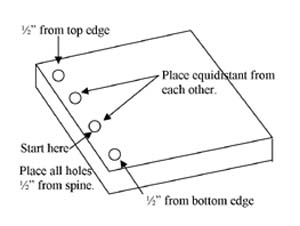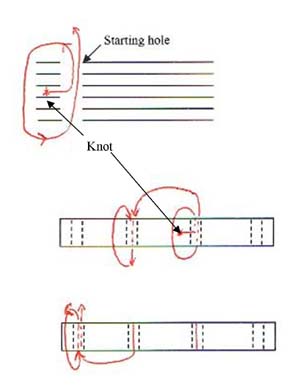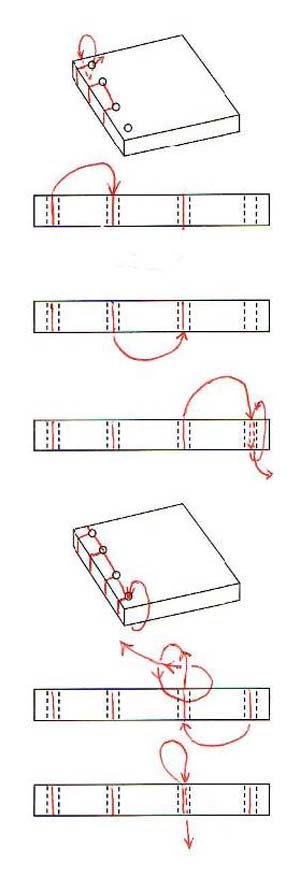
Pilinut Press, Inc.TM mobile
Publisher of Advanced Readers and How-To Books.

Publisher of Advanced Readers and How-To Books.
Simple bindings for your hand-crafted books are easy to do. They provide a more elegant and longer-lasting solution than staples or binder clips.
You can use a variety of materials for the cover. The cover can be made from card stock, file folders, heavy-weight papers, fabric, vinyl, or leather. Match the binding materials to the content of your book to reinforce the theme and protect it. Be careful about using wood since it contains chemicals which will degrade the interior pages. Use it only for a short-term decorative item. You can make a soft cover by using your choice of material without applying stiff cardboard backing. Make a hard cover by applying the material over cardboard cut to size. Cut two matching pieces of cardboard to form the front and back cover. Make them 1/16 of an inch larger in both height and width than the text pages. There is no overhang in this binding.
Any type of cord or string can be used for the stitching including yarns, raffia, leather thongs, jute string, twine, gimp, soft wire, thin ribbons, and fine braids. These are some of the more unusual choices for thread. On a traditional project you might use linen, embroidery, or carpet thread, strong nylon thread, or waxed dental floss.
In your initial book layout, be sure to allow space on each page for the spine. Spine depths will vary with the number of pages and the thickness of the paper. As a general rule allow ½” to ¾” of blank space on the side of the page which will be attached to the spine in addition to the margin around the writing.
Equipment. You will need an awl or a small nail and hammer, cardboard for a hard cover, material for the cover, cording or thread (eight times as long as the book’s height), binder clips, a needle, pencil, ruler, phone book or scrap wood to protect your work surface.
How to do it. These instructions follow Japanese book binding techniques to create a binding that will last.

Step 1. Measure ½” from the spine of the front cover and use your ruler to draw a line from the top to the bottom. On the line you have just drawn, make a mark ½” down from the top and ½” up from the bottom. Divide the distance between those two marks into thirds and mark two middle points. You should have four marks.
Step 2. Even up the pages of the book and place them between the front and back covers. Clamp with binder clips. Place on your protected work surface. If needed, weight down the pages to keep them from moving. Punch holes through the marks using the awl or a small nail and hammer. Do this in batches of 20 pages or less; otherwise pages and holes slip out of alignment. Once all pages are punched, stack them with holes aligned on the left hand side.

Step 3. Thread the needle with the thread. Tie the ends together in a knot. You now have a continuous loop of thread, the needle at one end, the knot at the other. Anchor the thread by opening the book about 20 pages and pushing the needle through the lower middle hole. Pull the thread until the knot is snugly fitted against the pages. Wrap the thread around the spine and push the needle through the lower middle hole again. Pull taut.

Step 4. Take the thread across the top cover to the upper middle hole. Push the needle down through that hole, around the spine and back down through the same hole. Pull the thread tight after each hole.
Step 5. Take the thread across the bottom cover and come up through the top hole. Go around the spine and up through the top hole again.
Step 6. Take the thread across the top of the cover so it crosses the top edge of the book (as opposed to the spine). Wrap the thread around this top edge and bring the thread up through the top hole.
Step 7. Take the thread across the top cover and down through the upper middle hole.
Step 8. Take the thread across the back cover and up through the lower middle hole.
Step 9. Take the thread across the top cover and down through the bottom hole. Wrap the thread around the spine. Take the thread down through the bottom hole again.
Step 10. Take the thread across the bottom cover so it crosses the bottom edge of the book. Wrap the thread around this bottom edge and bring the thread down through the bottom hole.
Step 11. Take the thread across the back cover to the starting hole. Bring the needle up through the starting hole. Tie off the thread tightly by slipping the needle under the two top threads coming out of the starting hole and back through the loop.
Step 12. Run the needle down through the starting hole and cut off the thread flush with the back of the book.
You can vary this basic binding by using different spacing of the holes and patterns of sewing. As a decorative feature, you can sew a stick, ribbon, or beads into the binding. Add the decoration along the spine if it is thick enough or on the front cover. Do remember to consider function first though. If the decoration will interfere with reading the book, do not use it.
